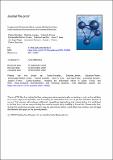Por favor, use este identificador para citar o enlazar a este item:
http://hdl.handle.net/10261/234423COMPARTIR / EXPORTAR:
 SHARE SHARE
 CORE
BASE CORE
BASE
|
|
| Visualizar otros formatos: MARC | Dublin Core | RDF | ORE | MODS | METS | DIDL | DATACITE | |

| Título: | Imaging the Kirkendall effect in pyrite (FeS2) thin films: Cross-sectional microstructure and chemical features |
Autor: | Morales, Carlos; Leinen, Dietmar; Flores, Eduardo CSIC ORCID; Muñoz-Cortés, Esmeralda; Leardini, Fabrice; Ares, José R.; Flege, Jan Ingo; Soriano, Leonardo; Ferrer, Isabel J.; Sánchez, Carlos | Palabras clave: | PyriteTEM Cross-sections Kirkendall effect Sodium doping |
Fecha de publicación: | 15-feb-2021 | Editor: | Elsevier BV | Citación: | Acta Materialia 205: 116582 (2021) | Resumen: | This investigation provides novel data on the structure and chemical composition of pyrite thin films and new hints concerning their formation mechanism. From TEM-HAADF data, it has been found that the films are composed of two different layers: one is very compact and the other one is quite porous with many voids separating a few groups of grains. This porous layer is always in direct contact with the substrate, and its thickness is quite similar to that of the original Fe film. The average size of pyrite grains is equal in both layers, what suggests that the same process is responsible for their formation. Concentration profiles of sulfur, iron and some impurities (mainly sodium and oxygen from the glass substrate) through both layers are given in this work, and thus chemical inhomogeneities of the films are proved by the obtained stoichiometric ratios (). Moreover, Na from sodalime glass substrates mainly accumulates at the pyrite grain boundaries and barely dopes them. The obtained results support the hypothesis that the iron sulfuration process essentially induces the diffusion of iron atoms, what leads to the porous layer formation as a manifestation of the Kirkendall Effect. Therefore, it seems that the same mechanisms that operate in the synthesis of surface hollow structures at the nanoscale are also active in the formation of pyrite thin films ranging from several tens to hundreds of nanometers. | Versión del editor: | https://doi.org/10.1016/j.actamat.2020.116582 | URI: | http://hdl.handle.net/10261/234423 | DOI: | 10.1016/j.actamat.2020.116582 | ISSN: | 1359-6454 |
| Aparece en las colecciones: | (IMN-CNM) Artículos |
Ficheros en este ítem:
| Fichero | Descripción | Tamaño | Formato | |
|---|---|---|---|---|
| Imaging Kirkendall effect_pre-proof.pdf | 2,28 MB | Adobe PDF |  Visualizar/Abrir |
CORE Recommender
SCOPUSTM
Citations
4
checked on 21-abr-2024
WEB OF SCIENCETM
Citations
5
checked on 24-feb-2024
Page view(s)
112
checked on 23-abr-2024
Download(s)
24
checked on 23-abr-2024
Google ScholarTM
Check
Altmetric
Altmetric
NOTA: Los ítems de Digital.CSIC están protegidos por copyright, con todos los derechos reservados, a menos que se indique lo contrario.
